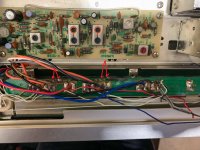I'm restoring a Sansui Eight receiver and ran into an issue with the F-1205 Lamp PCB.
The trace is partially lifted and is cut in 2 places.
In one of those places, it also seems to have been in contact with the brown wire and burned it slightly.
I've never repaired a trace before and need guidance on what would be the optimal way to repair this.
The trace is partially lifted and is cut in 2 places.
In one of those places, it also seems to have been in contact with the brown wire and burned it slightly.
I've never repaired a trace before and need guidance on what would be the optimal way to repair this.
Attachments
Take a solid blank wire just under the width of the track.
Stretch it out of ease using a vise and firm plier some 1-2% so it straithen (some sort of english) and harden a bit out.
Cut off the bent and bruised ends.
Adjust the length to needs.
Solder one side loosly, then the other side, then the one side good, then the full length without heating up the entire length (loosing grip).
Ends up into an almost indestructable 'new' track.
Next time, the component that burned the track will burn if not evaporate itself.
Solved.
The solidness and stretching is important however.
Stretch it out of ease using a vise and firm plier some 1-2% so it straithen (some sort of english) and harden a bit out.
Cut off the bent and bruised ends.
Adjust the length to needs.
Solder one side loosly, then the other side, then the one side good, then the full length without heating up the entire length (loosing grip).
Ends up into an almost indestructable 'new' track.
Next time, the component that burned the track will burn if not evaporate itself.
Solved.
The solidness and stretching is important however.
Last edited:
Cut across the tracks where they are fully intact and remove the damaged section.....heating the track whilst pulling upwards will release the foil where it is adhering to the board.
Clean the pcb with a brush and isopropyl alcohol and inspect closely.
With the back of a box cutter blade scrape away 3mm or so of the green lacquer exposing the copper and tin the copper foil being careful not to overheat which causes track lifting.
Straighten a length of Cat5 bare wire, tin one end and sweat the tinned end to one of the pretinned board pads.
Stretch the wire straight, and solder the other end to the other pad and then snip the excess wire off.
You may need to connect short jumpers from the straight wire to some of the pads.....close inspection will tell you where this is needed.
The damaged long thin pcb looks to be a dial lamp pcb.....inspect for shorts before repowering.
Dan.
Clean the pcb with a brush and isopropyl alcohol and inspect closely.
With the back of a box cutter blade scrape away 3mm or so of the green lacquer exposing the copper and tin the copper foil being careful not to overheat which causes track lifting.
Straighten a length of Cat5 bare wire, tin one end and sweat the tinned end to one of the pretinned board pads.
Stretch the wire straight, and solder the other end to the other pad and then snip the excess wire off.
You may need to connect short jumpers from the straight wire to some of the pads.....close inspection will tell you where this is needed.
The damaged long thin pcb looks to be a dial lamp pcb.....inspect for shorts before repowering.
Dan.
If you secure copper wire in a vise and wrap the other end round a strong bar/long screwdriver, then pull till it actually snaps (care needed with thicker wire), you'll work-harden it substantially as well as straighten it. It allows otherwise rather floppy copper to function directly as an antenna wire for instance.
Work hardened copper has somewhat higher electrical resistance, but its not a huge factor.
Work hardened copper has somewhat higher electrical resistance, but its not a huge factor.
- Status
- This old topic is closed. If you want to reopen this topic, contact a moderator using the "Report Post" button.
- Home
- Design & Build
- Construction Tips
- Repairing PCB trace on vintage Sansui
